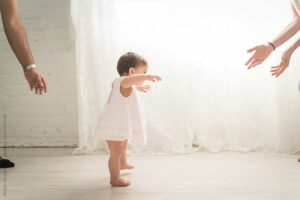Is your toddler actually “ok” if they fall and don’t have a broken bone, sprain or strain?
A toddler’s bones are made of cartilage, similar to your nose, or the hard part of your ears. Unlike the hard bones we as adults have, these cartilaginous bones have more flex to them, which is a good thing for all those toddler bum drops and head bonks when learning to walk!
A toddler’s ligaments are also looser than our adult ligaments. Ligaments are hard strands of connective tissue that connect one bone to another and maintain the stability in our joints. Babies and toddlers have very lax (loose) ligaments which allow their joints to bend further than adults preventing injury or sprain. Often parents are shocked when their toddler takes an accidental tumble off of something and does not seriously injure themselves. Although this does nothing to soothe mom or dad’s guilt, it does allow their baby to get by without serious harm.
But what about subtle injury underneath the surface? Do our babies actually get by keeping everything perfectly intact? Does their soft tissues, their cartilaginous bones and moveable joints, their nerves, and their function stay just as it was before all the falls?
Let’s think about it; imagine learning to walk, imagine falling on your bum over and over again multiple times throughout the day. Now add a week to that, and then a month, then a few months of bum falling and jarring before finally mastering the walk without regular tumbles. What is happening underneath the surface? All that repetitive trauma must do something right?
Right! What a lot of parents don’t realize is that even though there are no broken bones or sprains, there is no overt bruising, and their baby has no prolonged crying, there may actually be changes of spinal stress underneath the surface. With the daily stressors our little ones go through, a toddler’s spinal and pelvic joints may become “subluxed” (restricted or “misaligned”) under the surface after these seemingly un-scathing tumbles. Because tiny joints in the sacrum (tailbone area), pelvis, and lower back are just that, tiny… parents and many health care practitioners may not notice the subtle changes in mobility, alignment, and function in these usually very moveable joints.
Restrictions such as these that go undetected and uncorrected may cause an increased lack of motion and suboptimal function as your baby grows. Given that these bum falling structures, along with the rest of your baby’s spinal bones, “house” the most important information technology we have in the human body – your nervous system – it may not be something we want to ignore!
Having a chiropractor complete a spinal assessment on your little one is a great idea! Just as you would have their growing teeth checked at the dentist, it is important to check their spine as well. The chiropractors at WVCWG are specifically trained to detect and correct subluxed spinal and pelvic joints for your toddler and address the neurological changes that may go along with it. Consider having your little one checked before their next fall.
By: Dr. Cheryl van der Mark, B. Sc., D.C., F.I.C.P.A.

